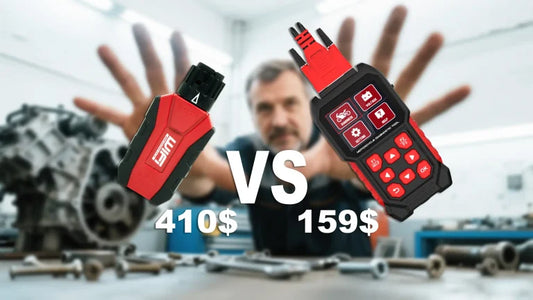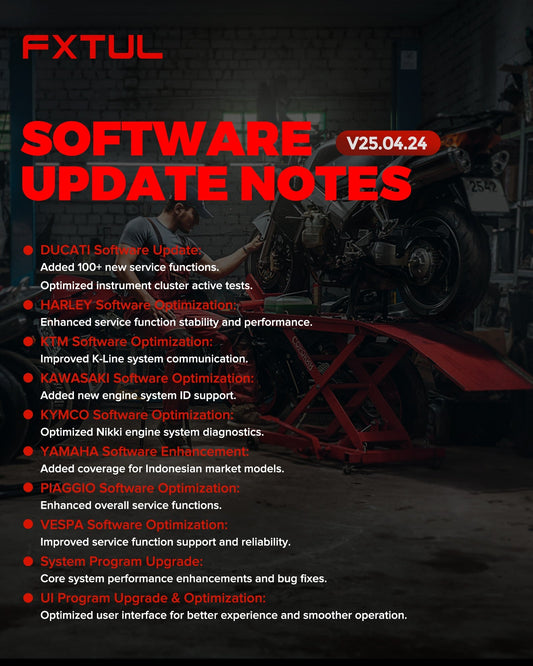What is ECU flashing?
The ECU (Engine Control Unit) is the "brain" of your motorcycle. It controls core parameters like fuel injection quantity, ignition timing, and throttle response through built-in programs (maps), directly impacting vehicle performance, fuel consumption, and emissions.
ECU flashing involves connecting to the ECU using specialized equipment to read, modify, and rewrite this control program.
Imagine this: The factory ECU program is a compromise, designed to meet global emissions regulations, fuel quality, driving habits, and cost controls. Flashing the ECU means customizing a more precise set of "brain instructions" tailored to your driving style and local environment.
Why flash the ECU?
Potential Benefits:
1. Remove horsepower restrictions: Especially for European and Japanese-spec vehicles, the factory may limit rpm or intake air volume to meet regulations. Flashing can unlock this trapped power.
2. Optimize fueling and ignition: Especially after modifications to the intake and exhaust systems, the factory programming cannot adapt to the increased intake air volume and exhaust flow, resulting in reduced combustion efficiency (too lean or too rich). Flashing can re-match the engine, restore smoothness, and increase power.
3. Improve throttle response: Eliminate the factory-set throttle lag for "smoothness," ensuring instant power and more direct control.
4. Disable or adjust electronic assists: For example, disabling the exhaust valve or adjusting the timing of traction control (TC) intervention.
5. Adjust the rev limiter: Allowing the engine to reach higher rpm within a safe range.
Risks and Drawbacks You Must Be Aware of:
1. Void the factory warranty: This is the most common and direct consequence. Flashing the engine likely voids the warranty on the engine and related systems. 2. Risk of Engine Damage: A poorly designed program can cause knocking, an excessively lean air-fuel ratio (leading to high-temperature piston meltdown), an excessively rich air-fuel ratio (causing carbon deposits and spark plug contamination), and in severe cases, even cylinder scuffing or explosion.
3. Excessive Emissions: After flashing, the vehicle may fail its annual inspection (emission testing) and is environmentally unfriendly.
4. Operational Errors: A power outage or malfunction during the flashing process can cause the ECU program to fail, bricking the ECU and preventing it from starting, resulting in costly repairs.
5. Cost-Effectiveness: For small-displacement or already well-optimized vehicles, the power increase may not be noticeable, but the cost and risk are substantial.
Pre-Flash Preparation (Knowledge, Tools, Software)
1. Knowledge Base:
· Understand your motorcycle's ECU type (e.g., Bosch, Mitsubishi, Delphi, etc.).
· Define your modification project and desired goals (e.g., modifying the entire exhaust system to improve mid-range torque).
· Learn basic technical terms: AFR (Air-Fuel Ratio), Ignition Timing, and Knock Sensor.
2. Hardware Tools:
· OBD-II diagnostic interface cable or dedicated ECU cable: Used to connect the motorcycle's diagnostic interface to a computer.
· A stable laptop: Ensure the battery is fully charged, preferably connected to a charger.
· A reliable power source: It is strongly recommended to connect the motorcycle to a smart charger (Battery Tender) to ensure stable voltage during the flashing process and to avoid power outages.
· ECU flashing equipment: This is the core hardware. Common examples include:
· Professional equipment: Examples include Autotune and Power Commander accessories (e.g., Power Vision). · Open-source/DIY devices: Such as the TunerPro with a specific USB to K-Line/Kayline cable (requires high technical skills, not recommended for beginners).
· Brand-specific devices: Many tuning companies offer their own handheld flashing devices, such as RapidBike and DNA.
3. Software and Programs (Maps):
· Flashing software: This is typically provided by the hardware vendor.
· Tuning programs (Tune/Map files):
· Pre-written maps: These can be purchased or downloaded from reputable tuning company websites; they typically provide tested and stable programs for common vehicle models and modification combinations.
· Custom tuning: A professional tuner customizes your vehicle on a dyno. This is the best but most expensive option.
· Absolutely prohibited: Downloading so-called "free hacks" from unidentified sources is the quickest way to ruin your vehicle.
General ECU Flashing Steps
Warning: The following steps are general procedures. Specific instructions must strictly follow the official manuals for the device and software you are using!
1. Connect the device:
· Put the motorcycle in neutral with the key off.
· Connect the battery charger.
· Find the OBD diagnostic port (usually under the seat) and connect the flashing device to the motorcycle and computer.
2. Read the factory program (Backup! Backup! Backup!):
· Open the flashing software and select the "Read ECU" or "Backup Stock Map" function.
· This is the most important step! Be sure to back up the entire factory program to your computer and store it safely. This is a life-saving "repentance pill."
3. Select and write the new program:
· Select the new program file you downloaded or purchased in the software.
· Carefully verify that the program is compatible with your vehicle model, engine displacement, and modifications.
· Execute the "Write to ECU" or "Flash" function. Do not touch the key, turn off the power, or disconnect the power cord during this process.
4. Wait for Completion:
· The flashing process typically takes several minutes, and the software will display a progress bar. Wait patiently until "Flash Successful" or a similar message appears.
5. Shutdown and Restart:
· Follow the software prompts to completely power off the motorcycle, wait a few seconds, and then re-key the keyless entry (no need to start it immediately). This will allow the ECU to complete its self-learning reset.
6. Start and Test:
· Start the engine. It may take a little longer than usual to start, which is normal.
· Idle: Allow the engine to idle for 5-10 minutes and observe for any unusual vibrations, unusual noises, or a fault light.
· Road Test: For the initial road test, drive gently to feel the throttle response and smoothness. Gradually accelerate at low and medium rpms. Once no abnormalities are present, try high rpm.
Conclusion and Final Warning
Flashing the ECU is a powerful tool for improving motorcycle performance, but it's a double-edged sword.
· If you don't have a deep understanding of motorcycle electronic control systems, are extremely meticulous, and are willing to assume all risks.
· If your vehicle is still under warranty.
In that case, please leave this specialized work to professionals.




